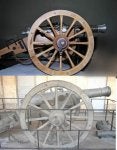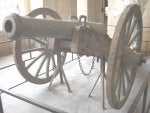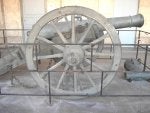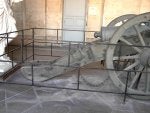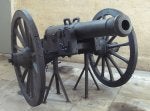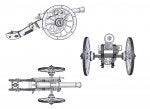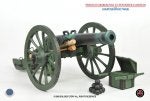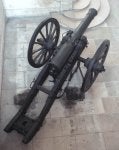Hello to everyne,
today,I received the SS Gribeauval version.Compared to DiDs version,there are some differences.First, DiDs quality of paint and wood is better.SS has some minor paint problems and wood has a minor split-off.One screw had disappeared and I had to look in the box for it.What is really a bad point is that the right handle is pushed in a little bit on the top angle.Not that bad but disappointing.Geometry (of carriage) has some problems too (that was the same for DiD).Overall,it seems to have better accuracy,especially the wheels and the tube.The limber of course is a nice addition and well made.
Now for the specialists (for ex.Tony Barton):I first was unsure about the correct sizes of the tubes.But now I think SS has the correct size.It´s overall length is 42,and to the first ring (seen from muzzle 38).According to Tony Barton (and Osprey) the exact original length of the gun tube was 229cm , from base ring to muzzle.That would be ok for the SS version.So,what is the DiD version?Maybe a 8 pounder?Does anyone have the exact sizes for the 4 and 8 pound Gribeauval cannons?
We´ve seen that DidD had often problems with the sizes.For example length of sabre of the British hussar.So probably they made a mistake with the Cannon also.
Conclusion iDs version is better quality,SS seems to be more accurate,but it´s price is too high.And now I seem to have an arsenal of different calibres.
iDs version is better quality,SS seems to be more accurate,but it´s price is too high.And now I seem to have an arsenal of different calibres.
Happy week-end to everyone.
today,I received the SS Gribeauval version.Compared to DiDs version,there are some differences.First, DiDs quality of paint and wood is better.SS has some minor paint problems and wood has a minor split-off.One screw had disappeared and I had to look in the box for it.What is really a bad point is that the right handle is pushed in a little bit on the top angle.Not that bad but disappointing.Geometry (of carriage) has some problems too (that was the same for DiD).Overall,it seems to have better accuracy,especially the wheels and the tube.The limber of course is a nice addition and well made.
Now for the specialists (for ex.Tony Barton):I first was unsure about the correct sizes of the tubes.But now I think SS has the correct size.It´s overall length is 42,and to the first ring (seen from muzzle 38).According to Tony Barton (and Osprey) the exact original length of the gun tube was 229cm , from base ring to muzzle.That would be ok for the SS version.So,what is the DiD version?Maybe a 8 pounder?Does anyone have the exact sizes for the 4 and 8 pound Gribeauval cannons?
We´ve seen that DidD had often problems with the sizes.For example length of sabre of the British hussar.So probably they made a mistake with the Cannon also.
Conclusion
Happy week-end to everyone.



